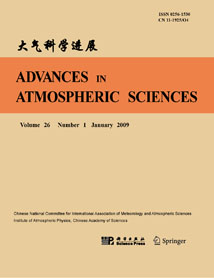| [1] |
Yunyun LIU, Zeng-Zhen HU, Renguang WU, Xing YUAN,
2022: Causes and Predictability of the 2021 Spring Southwestern China Severe Drought, ADVANCES IN ATMOSPHERIC SCIENCES, 39, 1766-1776.
doi: 10.1007/s00376-022-1428-4
|
| [2] |
Minwei Qian, N. Loglisci, C. Cassardo, A. Longhetto, C. Giraud,
2001: Energy and Water Balance at Soil-Air Interface in a Sahelian Region, ADVANCES IN ATMOSPHERIC SCIENCES, 18, 897-909.
|
| [3] |
Hongxiong XU, Dajun ZHAO,
2021: Effect of the Vertical Diffusion of Moisture in the Planetary Boundary Layer on an Idealized Tropical Cyclone, ADVANCES IN ATMOSPHERIC SCIENCES, 38, 1889-1904.
doi: 10.1007/s00376-021-1016-z
|
| [4] |
Hongxiong Xu, Dajun Zhao,
2023: Effect of the vertical diffusion of moisture in the planetary boundary layer on an idealized tropical cyclone, ADVANCES IN ATMOSPHERIC SCIENCES.
doi:
|
| [5] |
JIE Weihua, WU Tongwen, WANG Jun, LI Weijing, LIU Xiangwen,
2014: Improvement of 6-15 Day Precipitation Forecasts Using a Time-Lagged Ensemble Method, ADVANCES IN ATMOSPHERIC SCIENCES, 31, 293-304.
doi: 10.1007/s00376-013-3037-8
|
| [6] |
LIU Ge, WU Renguang, ZHANG Yuanzhi, and NAN Sulan,
2014: The Summer Snow Cover Anomaly over the Tibetan Plateau and Its Association with Simultaneous Precipitation over the Mei-yu-Baiu region, ADVANCES IN ATMOSPHERIC SCIENCES, 31, 755-764.
doi: 10.1007/s00376-013-3183-z
|
| [7] |
Chibuike Chiedozie IBEBUCHI,
2023: Circulation Patterns Linked to the Positive Sub-Tropical Indian Ocean Dipole, ADVANCES IN ATMOSPHERIC SCIENCES, 40, 110-128.
doi: 10.1007/s00376-022-2017-2
|
| [8] |
Tian FENG, Fumin REN, Da-Lin ZHANG, Guoping LI, Wenyu QIU, Hui YANG,
2020: Sideswiping Tropical Cyclones and Their Associated Precipitation over China, ADVANCES IN ATMOSPHERIC SCIENCES, 37, 707-717.
doi: 10.1007/s00376-020-9224-5
|
| [9] |
Kalim ULLAH, GAO Shouting,
2012: Moisture Transport over the Arabian Sea Associated with Summer Rainfall over Pakistan in 1994 and 2002, ADVANCES IN ATMOSPHERIC SCIENCES, 29, 501-508.
doi: 10.1007/s00376-011-0200-y
|
| [10] |
CHEN Guanghua,
2011: A Comparison of Precipitation Distribution of Two Landfalling Tropical Cyclones during the Extratropical Transition, ADVANCES IN ATMOSPHERIC SCIENCES, 28, 1390-1404.
doi: 10.1007/s00376-011-0148-y
|
| [11] |
Jie JIANG, Yuqing WANG,
2022: The Roles of Barotropic Instability and the Beta Effect in the Eyewall Evolution of Tropical Cyclones, ADVANCES IN ATMOSPHERIC SCIENCES, 39, 1800-1815.
doi: 10.1007/s00376-021-1209-5
|
| [12] |
Gudongze LI, Haoming CHEN, Mingyue XU, Chun ZHAO, Lei ZHONG, Rui LI, Yunfei FU, Yanhong GAO,
2022: Impacts of Topographic Complexity on Modeling Moisture Transport and Precipitation over the Tibetan Plateau in Summer, ADVANCES IN ATMOSPHERIC SCIENCES, 39, 1151-1166.
doi: 10.1007/s00376-022-1409-7
|
| [13] |
Li Wei, Yu Rucong, Zhang Xuehong,
2001: Impacts of Sea Surface Temperature in the Tropical Pacific on Interannual Variability of Madden-Julian Oscillation in Precipitation, ADVANCES IN ATMOSPHERIC SCIENCES, 18, 429-444.
doi: 10.1007/BF02919322
|
| [14] |
Xinyu LI, Riyu LU,
2018: Subseasonal Change in the Seesaw Pattern of Precipitation between the Yangtze River Basin and the Tropical Western North Pacific during Summer, ADVANCES IN ATMOSPHERIC SCIENCES, 35, 1231-1242.
doi: 10.1007/s00376-018-7304-6
|
| [15] |
Linjun HAN, Fuzhong WENG, Hao HU, Xiuqing HU,
2024: Cloud-Type-Dependent 1DVAR Algorithm for Retrieving Hydrometeors and Precipitation in Tropical Cyclone Nanmadol from GMI Data, ADVANCES IN ATMOSPHERIC SCIENCES, 41, 407-419.
doi: 10.1007/s00376-023-3084-8
|
| [16] |
Jihang LI, Zhiyan ZHANG, Lu LIU, Xubin ZHANG, Jingxuan QU, Qilin WAN,
2021: The Simulation of Five Tropical Cyclones by Sample Optimization of Ensemble Forecasting Based on the Observed Track and Intensity, ADVANCES IN ATMOSPHERIC SCIENCES, 38, 1763-1777.
doi: 10.1007/s00376-021-0353-2
|
| [17] |
Xiaohao QIN, Wansuo DUAN, Pak-Wai CHAN, Boyu CHEN, Kang-Ning HUANG,
2023: Effects of Dropsonde Data in Field Campaigns on Forecasts of Tropical Cyclones over the Western North Pacific in 2020 and the Role of CNOP Sensitivity, ADVANCES IN ATMOSPHERIC SCIENCES, 40, 791-803.
doi: 10.1007/s00376-022-2136-9
|
| [18] |
Yitian ZHOU, Ruifen Zhan, Yuqing Wang, Zhipeng XIE, Xiuwen NIE, Peiyan Chen, Zhe-Min Tan,
2024: A Physics-informed-deep-learning Intensity Prediction Scheme for Tropical Cyclones over the western North Pacific, ADVANCES IN ATMOSPHERIC SCIENCES.
doi: 10.1007/s00376-024-3282-z
|
| [19] |
LI Rui, FU Yunfei,
2005: Tropical Precipitation Estimated by GPCP and TRMM PR Observations, ADVANCES IN ATMOSPHERIC SCIENCES, 22, 852-864.
doi: 10.1007/BF02918685
|
| [20] |
Ruifen ZHAN, Yuqing WANG, Yihui DING,
2022: Impact of the Western Pacific Tropical Easterly Jet on Tropical Cyclone Genesis Frequency over the Western North Pacific, ADVANCES IN ATMOSPHERIC SCIENCES, 39, 235-248.
doi: 10.1007/s00376-021-1103-1
|















 AAS Website
AAS Website 
 AAS WeChat
AAS WeChat 
 DownLoad:
DownLoad: